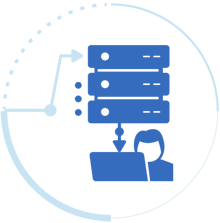Last Updated on December 16, 2024 by Deepanshu Sharma

In today’s data-driven world, organizations face numerous challenges in managing and securing their sensitive information. With the increasing volume and complexity of data, it becomes crucial to implement robust measures for effective data access governance (DAG). This blog aims to provide a comprehensive understanding of data access governance, its principles, challenges, and steps to successfully implement a DAG program. Additionally, we will explore how Lepide, a leading data security solution, can assist organizations in their data access governance efforts.
What is Data Access Governance?
Data Access Governance (DAG) refers to the process of managing and controlling access to an organization’s data resources. It involves defining and enforcing policies, procedures, and controls to ensure that only authorized individuals can access and use sensitive data. DAG encompasses various aspects such as user access management, role-based access control (RBAC), and compliance with regulatory requirements.
The Goals of Data Access Governance
Data access governance aims to make high-quality and relevant data accessible while ensuring its security and availability. To achieve effective governance, it is important to consider the needs of all data handlers within the organization. Since data can be stored in unpredictable and unsecure locations, organizations must discover, label, and categorize data to determine its value and appropriate storage location. This ensures that data is accessible only to authorized individuals.

The Principles of Data Access Governance
- Least Privilege: Grant users the minimum access required to perform their job functions. Limiting access helps reduce the risk of unauthorized data exposure or misuse.
- Segregation of Duties: Implement controls to prevent conflicts of interest by separating incompatible tasks among different individuals. This ensures that no single user has complete control over critical data.
- Continuous Monitoring: Regularly monitor user activities and access rights to identify any suspicious behavior or policy violations. Monitoring helps maintain data integrity and enhances security.
- Accountability and Auditing: Establish mechanisms to track and log user actions, providing an audit trail for accountability. Auditing facilitates compliance reporting and aids in investigations if a security incident occurs.
Data Governance Challenges
Implementing an effective data access governance program comes with several challenges, including:
- Complex Data Environments: Managing data across diverse systems, applications, and platforms can be challenging, requiring a comprehensive approach to access control.
- User Provisioning and Deprovisioning: Ensuring timely user onboarding and revoking access when an employee leaves the organization is critical. Ineffective processes can result in orphaned accounts or unauthorized access.
- Regulatory Compliance: Meeting industry-specific regulations, such as GDPR or HIPAA, demands a strong data access governance framework to protect sensitive information and avoid penalties.
- Balancing Security and Productivity: Striking a balance between strict security measures and user productivity can be a delicate task. Overly stringent controls can hinder efficient data access, while lax controls increase the risk of data breaches.
Components of a Successful Data Governance Strategy
A successful data governance strategy must integrate both long-term and short-term goals set by a team of experts, including representatives from management, IT, and other relevant stakeholders. Developing an effective data governance strategy is a complex but essential task that requires a combination of manual and automated methods. A data governance tool should be used which integrates data discovery and classification across the organization, ensuring that data is stored securely and in compliance with the relevant data privacy laws.
Below are the key components of a successful data governance strategy:
- Clear goals and objectives that align with business objectives
- A defined governance framework and organizational structure
- Policies for data classification and access control
- Policies and procedures for data management and usage
- Data quality standards and controls
- A data dictionary and metadata management system
- A data lineage and audit trail
- Regular assessments and monitoring of compliance
- Stakeholder involvement and communication
- Training and education programs on data governance and best practices.
How Lepide Helps with Data Access Governance
Lepide offers a comprehensive data security solution that assists organizations in implementing effective data access governance. Its features include:
Data Classification: Automatically identify sensitive data across various systems and classify it based on predefined or custom policies.
Access Control: Utilize granular access control reports to enforce least privilege and segregation of duties, preventing unauthorized data access. Lepide even comes with a dedicated excessive permissions report so that you can quickly see which users do not need access to sensitive data.
User Behavior Analytics: Monitor user activities and detect suspicious behavior or policy violations using advanced analytics, anomaly spotting, and real time alerts.
Audit and Compliance Reporting: Generate detailed audit logs and compliance reports to meet regulatory requirements and facilitate internal and external audits.
Effective data governance is crucial for business success, and a successful data governance strategy must ensure that all critical components are in place, enabling organizations to collect, store, and use data reliably and efficiently.
If you would like to see how the Lepide Data Security Platform can help you implement and maintain a successful Data Access Governance program, schedule a demo with one of our engineers.


 Group Policy Examples and Settings for Effective Administration
Group Policy Examples and Settings for Effective Administration 15 Most Common Types of Cyber Attack and How to Prevent Them
15 Most Common Types of Cyber Attack and How to Prevent Them Why AD Account Keeps Getting Locked Out Frequently and How to Resolve It
Why AD Account Keeps Getting Locked Out Frequently and How to Resolve It
